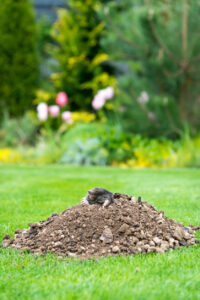
Need Help? Call Us On 0161 776 9832 For Expert Pest Control Advice On How To Identify Pest Infestations And Help Solve Your Pest Problem.
Professional Radcliffe Mole Trapping and Control
A Mole Hill Can be a Mountain!
About a Mole
 Moles are small, cylindrical mammals about 80 grams in size. Their velvety fur can be coloured from grey to black. They have reduced back legs and powerful front legs with large paws for digging, and short tails. Moles appear to have no eyes, but their eyes are merely well hidden. They can distinguish between light and dark using their eyes, but they also have sensory hair on their short tails, on their chin and face and also behind their ears which allow them to sense movement.
Moles are small, cylindrical mammals about 80 grams in size. Their velvety fur can be coloured from grey to black. They have reduced back legs and powerful front legs with large paws for digging, and short tails. Moles appear to have no eyes, but their eyes are merely well hidden. They can distinguish between light and dark using their eyes, but they also have sensory hair on their short tails, on their chin and face and also behind their ears which allow them to sense movement.
They spend much of their lives in the several layers of tunnels they dig (surface tunnels for short term activity and deeper tunnels for breeding and feeding), but they often venture to the surface to forage, especially during warm, rainy periods. Their main diet is worms and insects. Mole runs underground are essentially worm traps, as the moles use their sensory hair to 'feel' when a worm drops into their tunnel, then they quickly run to kill and eat it.
How do I Know if I need Mole Control?
Moles do not hibernate, so can be active all your round, although they tend to be most active in spring and autumn. Moles dig surface tunnels to move around and to find mates, and this digging can often disturb plant roots, resulting in poor plant growth. After a lovely spring rain, moles also like to forage around in the soft, loamy soil for worms and insects This activity often results in uprooted plants and vegetables, and even holes in lawns.
So if you have uprooted plants, poor plant growth or holes in your garden then you should look for raised swellings as these could be indications of mole tunnels. Another sign of mole activity is molehills, small mounds of dirt which are merely the waste material from the moles actively digging or repairing tunnels. Moles are most active early morning or in the evening, so you may even be able to actually see them at work in your garden.
What Mole Control is Right for Me?
 Although moles are not a protected species, they are covered under cruelty to animal legislation, and as such Radcliffe mole trapping and control can be problematic, so it would be wise to consider a mole pest control experts like Young's Pest Control.
Although moles are not a protected species, they are covered under cruelty to animal legislation, and as such Radcliffe mole trapping and control can be problematic, so it would be wise to consider a mole pest control experts like Young's Pest Control.
Even if we are simply carrying out Radcliffe mole trapping, our experts at Young's Pest Control handle the situation efficiently and humanely ensuring you soon have your garden back in pristine condition.
